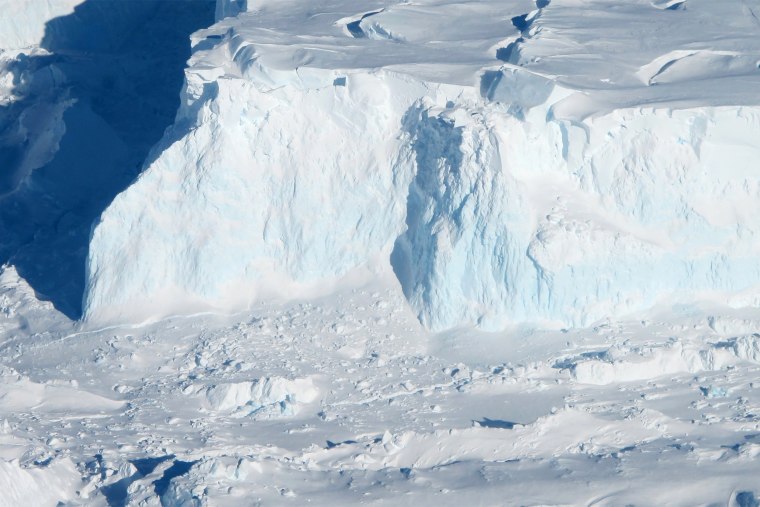Top scientists say the world’s ice sheets are melting more rapidly than expected and that world leaders must ramp up their climate ambitions to avoid a catastrophic rise in sea levels.
A report released Thursday from the International Cryosphere Climate Initiative, a network of policy experts and researchers, pleads with world leaders to heed their warnings as they gather for the United Nations’ COP28 climate conference later this month. The report says if global average temperatures settle at 2 degrees Celsius above the preindustrial baseline, the planet could be committed to more than 40 feet of sea-level rise — a melt that would take centuries and reshape societies across the globe.
The collapse of ice sheets and ice shelves has been a major point of uncertainty within the climate science community. But a flurry of new research suggests that dangerous tipping points are nearer than once thought and that there is likely less room in Earth’s carbon budget than expected.
“We might be reaching these temperature thresholds that we’ve been talking about for a long time sooner than we were thinking about years ago,” said Rob DeConto, the director of the University of Massachusetts Amherst School of Earth & Sustainability and an author of the report. “And it may be that the thresholds for some of these processes that can drive really rapid ice loss are lower than we were thinking just a few years ago.”
Without a dramatic turn in the pace of climate action, those factors could leave humanity “facing rates of sea-level rise way outside the range of adaptability,” DeConto said.
In the report, the scientists argue a rise in global temperatures of 2 degrees Celsius would force many to flee coastal communities.
“We’re displacing millions of people with the decisions being made now,” said report author Julie Brigham-Grette, a geosciences professor at the University of Massachusetts Amherst.
More than 60 scientists contributed to the report. Many are experts in their specialties, and some have worked on past reports for the U.N.’s Intergovernmental Panel on Climate Change, the world’s leading body on assessing the climate crisis.
In the IPCC’s 2021 report, scientists estimated that sea level will rise about 0.9 to 3.3 feet (0.28 to 1.01 meters) by 2100, but also said those numbers didn’t factor in uncertainties around ice sheets like the ones scientists have been probing more deeply in the past few years.
New studies suggest that melting ice sheets are a greater cause for concern than the IPCC had considered.
“Many ice sheet scientists now believe that by 2°C, nearly all of Greenland, much of West Antarctica, and even vulnerable portions of East Antarctica will be triggered to very long-term, inexorable sea-level rise, even if air temperatures later decrease,” the new ICCI report says.
The new report also outlines how the declining mass of mountain glaciers threatens hydropower supplies and endangers drinking water sources, how permafrost could intensify warming by releasing massive amounts of methane, and how polar waters are becoming increasingly acidified, which threatens the survival of shell-building creatures like krill and crab.
World leaders in 2015 agreed to limit warming to well below 2 degrees C and also to aim for 1.5 degrees. But many countries are struggling to cut fossil fuels from their economies, and efforts remain off pace to limit warming. A 2022 U.N. report found the planet was on track to warm about 2.8 C above preindustrial times by 2100.
A recent United Nations Environment Programme report found that world leaders plan to extract and produce twice the amount of fossil fuels needed to keep global temperatures from exceeding 1.5 degrees C.
This year, scientists have observed a slew of concerning signs for the world’s ice.
Antarctic sea ice reached its lowest-ever maximum since scientists began measuring in 1979, a possible sign that climate change could be making an impact in what has been a more resilient region for sea ice.
Swiss glaciers lost about 10% of their remaining mass in the past two years, the report says. And Greenland experienced the second-highest surface melt in recorded history.
Meanwhile, scientists revealed new research that suggests the collapse of the West Antarctic Ice Sheet might already be inevitable and that Greenland’s glaciers are melting at five times the rate they were 20 years ago. And another group of scientists found that the remaining carbon budget to limit warming was far smaller than once thought. At the current pace, the scientists believe global average temperatures will reach 1.5 degrees Celsius above preindustrial levels in about six years.
The authors hope the new ICCI report will influence negotiations at COP28, the climate discussions among world leaders that are slated to take place in Dubai from Nov. 30 to Dec. 12.
“We’re committing today’s kindergartners to a very different future,” Brigham-Grette said, adding that policymakers’ “selective hearing is the problem.”
Added DeConto: “While some change has already been set in motion, the truly dire impacts of cryosphere loss can be avoided with immediate reductions in carbon emissions.”
